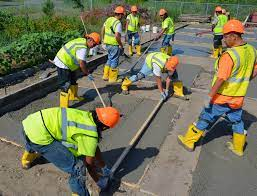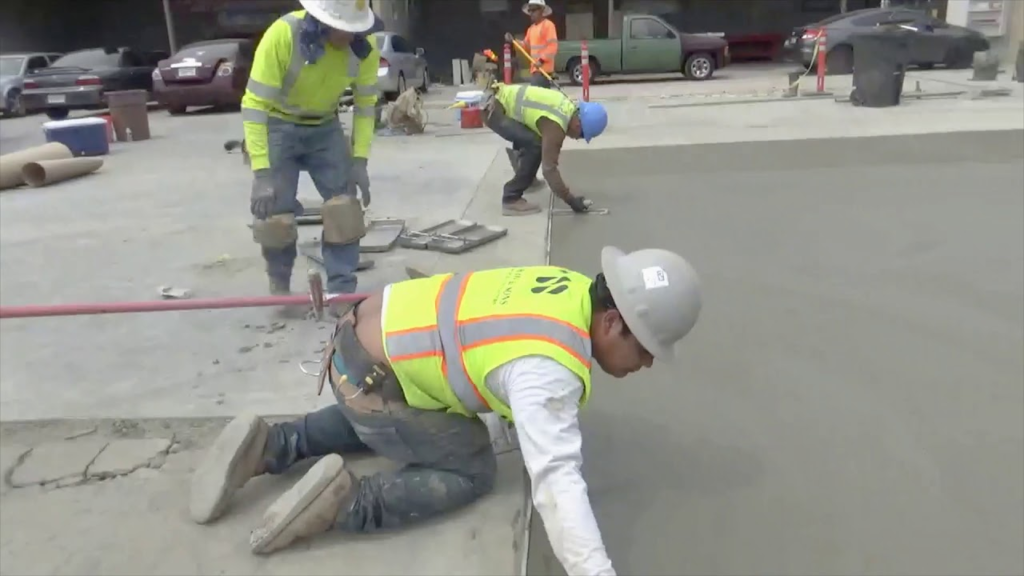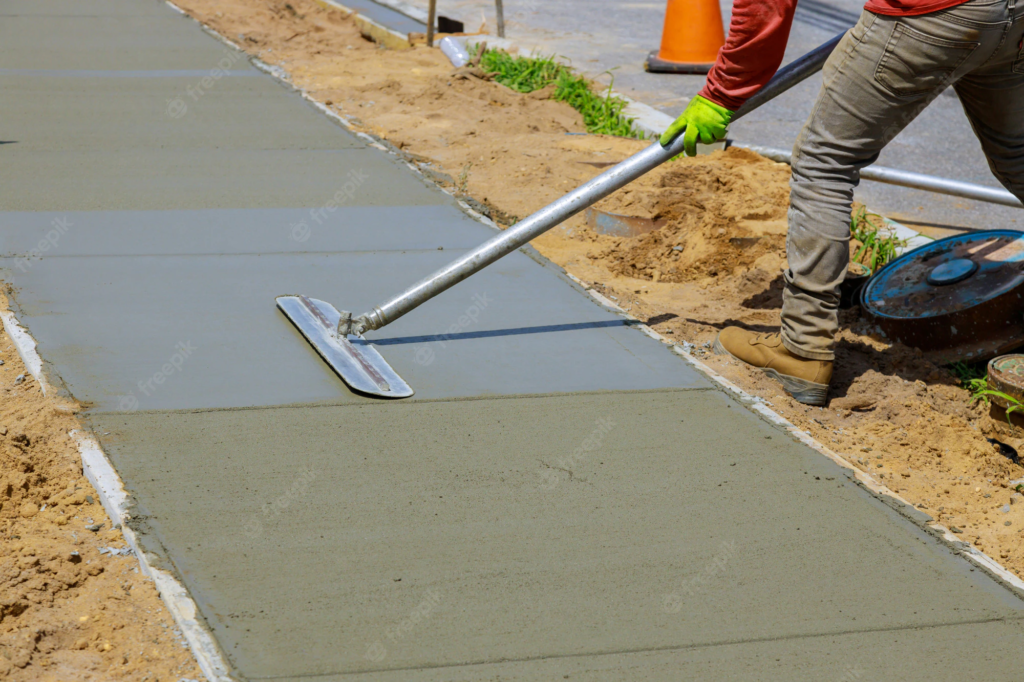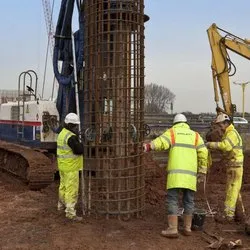Mason Concrete (6 month course)
Mason Concrete click here
Brief Job Description
The job role is responsible for placing, leveling and finishing both RCC and PCC in various structural
elements, in situ and in pre cast units. This also includes repairing of concrete and carrying out IPS/Tremix
flooring.

Personal Attributes
This job role requires the individual to be physically fit and should be able to work across various locations withstanding extreme weather/site conditions while working at the construction site or in a casting yard. The person must be able to perform efficiently within a team and handle the various concreting tools and materials and work responsibly.
Carry out IPS / Trimix flooring works
Description
This unit describes the skills and knowledge required to work on IPS & Tremix flooring
Scope
The scope covers the following :
Carry out preparatory work prior to IPS / Trimix flooring
Check for line, level and alignment.
Check the materials used for IPS / Trimix flooring in case of manual mixing
Check the materials used for IPS / Trimix flooring in case of machine mixing
Carry out IPS flooring
Carry out Trimix / VDF flooring
Elements and Performance Criteria
Carry out preparatory work prior to IPS / Trimix flooring
To be competent, the user/individual on the job must be able to:
PC1. inspect the work area prior to concreting, ensure levelling in case of any undulations
observed on the surface prior to concreting
PC2. ensure surface is prepared appropriately and report any deviation in slope and alignment in PCC
PC3. report any gaps in formwork to avoid leakage
PC4. report any misalignment in formwork/reinforcement and ensure proper cover for
reinforcement is provided
Check for line, level and alignment
To be competent, the user/individual on the job must be able to:
PC5. mark reference level on the wall &transfer this marking to all floor locations using
appropriates tools
PC6. mark flooring thickness level and provide dummy level dots at specified intervals for
ensuring required slope

Check the materials used for IPS / Trimix flooring in case of manual mixing
To be competent, the user/individual on the job must be able to:
PC7. check the grade of cement prior to use in case of manual mixing
PC8. ensure fine aggregate is sieved as per grade requirement
PC9. check that concrete is mixed in appropriate proportion
Check the materials used for IPS/Trimix flooring in case of machine mixing
To be competent, the user/individual on the job must be able to:
PC10. visually assess the concrete mix for usability and workability
PC11. notify superiors for detrimental quality of concrete
PC12. ensure specified concrete mix is used at allocated location
PC13. check that panels prepared are of specified size and type
Carry out IPS Flooring work
To be competent, the user/individual on the job must be able to:
PC14. fix the glass, aluminum or brass strip in cement mortar with their tops at appropriate level
and according to slope
PC15. ensure panels are made as per specified size
PC16. ensure concrete is poured in alternate panels/specified panels as per requirement
PC17. remove excess cement slurry and any marks on the surface
PC18. level the concrete surface with a straight edge and to the required finish with a wooden float
/ trowel
PC19. spread cement punning over the IPS concrete for smooth finish surface and allow it to soak
into the concrete, as per requirement
PC20. provide construction joints and expansion joints as per requirement
PC21. level poured concrete to the specified levels maintaining required slope
PC22. ensure curing of the finished floor surface for the specified time
Carry out Trimix / VDF Flooring work
To be competent, the user/individual on the job must be able to:
PC23. level the surface and lay stone soling / boulder soling layer
PC24. lay the floor with slope maintained in PCC work above the stone soling
PC25. remove excess water from the top layer of wet concrete without removing cement of sand
particles through vacuum de-watering machines
PC26. ensure floater work within green concrete surface
PC27. carry out Trimix flooring in specified panel on RCC floors ensuring intactness of rebar and
cover
PC28. cut grooves on concrete at specified intervals for construction joints
PC29. provide expansion joints as per requirement
PC30. carry out curing of finished concrete as per specifications
PC31. ensure finished levels have required slope
Knowledge and Understanding (KU)
The individual on the job needs to know and understand:
KU1. standard practices for masonry work
KU2. safety rules and regulation for handling and storing required masonry tools, equipment and
materials
KU3. personal protection including the use of related safety gears & equipment
KU4. to request tools and materials as per set procedures
KU5. maintenance of tools and equipment
KU6. how to use all masonry tools along with some specialized tools for Trimix flooring such as :
Vacuum de-watering Pump Floater Machine Double beam Screen Vibrator
KU7. process to prepare the sub-base by watering and ramming
KU8. provide for adequate slope in PCC (Plain Cement Concrete) in a base
KU9. how to make reference levels and transfer the markings to all locations where
KU10. various type and grade of cement used, affect of water /cement ratio and
KU11. different mix proportion/grade of concrete

KU12. sequence of concrete pouring and placing
KU13. manual mixing of concrete and nominal mix proportions
KU14. cover to reinforcement with respect to size of reinforcement
KU15. how to pour of concrete in alternate panels
KU16. how to avoid shrinkage cracks in concrete
KU17. various admixtures used in concreting
KU18. different type of vibrators, their influence area and use
KU19. construction and expansion joints
KU20. cutting tools for providing joints
KU21. final toweling process before the concrete is hardened
KU22. excess water removal process using Vacuum dewatered machine
KU23. use of screed vibrator
KU24. hardener usage along with floater machine (if required) at the time of finishing the floor
surface to increase abrasion resistance of the floor
KU25. how to provide for space for narrow passage for operating float vibrator along a wall
Generic Skills (GS)
User/individual on the job needs to know how to:
GS1. write in at least one language, preferably in the local language of the site
GS2. read in one or more or more language, preferably the local language at the site
GS3. read sketches provided by the superior to do IPS /Tremix flooring works
GS4. read instructions, guidelines, sign boards, safety rules and safety tags
GS5. read instructions and exit routes during emergency
GS6. speak in one or more language, preferably one of the local language at the site
GS7. listen and follow instructions given by the supervisors
GS8. orally and effectively communicate with co-workers & subordinates
GS9. decide whether the work place is safe for working and also relevant task is not creating
hazardous condition for others
GS10. decide whether work is adequately defined for the day , work front is clear , and adequate
materials and tools are available for performing work
GS11. plan work and organize required resources in coordination with team members and superiors
GS12. complete work as per the agreed time schedule & quality
GS13. resolve and solve any conflict within the team
GS14. bring any noticeable issues faced (related to the flooring) to the attention of the superiors in
a timely manner
GS15. assess quantity and quality of materials for day work
GS16. check quality of scaffolding / working platform from all aspects of safety
GS17. dispose of construction debris & keep workplace safe and tidy for working
GS18. optimize resources efficiently
GS19. minimize wastage in the workplace
GS20. starting and finishing levels for day work
GS21. reconcile material consumption
GS22. evaluate the complexity of the tasks and seek assistance and support wherever required
GS23. bring to the notice of the superior any requirements of the requisite material and resource
GS24. bring to the notice of the superiors violation of any safety norms which may lead to accidents
Place, level and finish concrete in various structural elements including repair works
Description
This unit describes the skills and knowledge required to place, level and finish concrete, both RCC and
PCC, in various structural elements in situ and pre cast .This also includes repair works on concrete.
Scope
The scope covers the following :
Carry out preparatory work before pouring of concrete in case of manual and machine mixing
Check material used for concreting in case of manual mixing
Place and compact concrete on PCC & RCC structural elements
Screed and level wet concrete
Finish and cure concrete
Carry out concreting in pre cast segments
Carry out simple repair work on hardened concrete surfaces
Elements and Performance Criteria
Carry out preparatory work before pouring of concrete manually & by machine
To be competent, the user/individual on the job must be able to:
PC1. inspect the area for completion of housekeeping works and remove any undulations on the
surface prior to concreting
PC2. ensure surface is prepared appropriately and report any deviation in slope and alignment
PC3. report any gaps in formwork to avoid leakage
PC4. report any misalignment in formwork/reinforcement and ensure proper cover for
reinforcement is provided
PC5. notify superiors for detrimental quality of concrete
PC6. visually assess the concrete mix for usability and workability
Check material used for concreting in case of manual mixing
To be competent, the user/individual on the job must be able to:
PC7. check the type , grade of cement and visual soundness of cement prior to use
PC8. check and ensure sieved fine aggregate prior to use
PC9. instruct and ensure that mixing of concrete is in specified ratio

Place and compact concrete on PCC & RCC structural elements
To be competent, the user/individual on the job must be able to:
PC10. handle and adjust the pouring equipments as per requirements
PC11. ensure standard pouring height for concrete is maintained throughout pouring
PC12. ensure pouring of concrete takes place in specified layers
PC13. pour concrete to maintain specified levels & cover for steel reinforcement
PC14. apply vibrator within influence depth and as per standard procedures
PC15. ensure that the vibrator does not touch the reinforcement or is not applied to the face of the
form
Screed and level wet concrete
To be competent, the user/individual on the job must be able to:
PC16. screed the concrete as per requirements using appropriate tools and technique
PC17. push the excess concrete towards the formwork for easy removal
PC18. float the concrete using appropriate tools
PC19. level the edges and corners as per requirements using appropriate tools for semi-finished
concrete
PC20. provide construction/ control joints in concrete surface at pre-defined locations
PC21. cut construction joints as per specification and requirements
Finish and cure concrete
To be competent, the user/individual on the job must be able to:
PC22. smoothen the surface using appropriate tools, to ensure a consistent and durable final finish
PC23. apply a final finish on the surface as per requirements using any of the following major
techniques: Stamped concrete finish, Stenciling concrete, finish Broom finish, Rock salt finish
PC24. provide shear key /vertical construction joint or cut construction joint as per requirement
PC25. ensure cleaning and removal of spilled concrete is carried out after work
PC26. ensure proper curing of concrete by marking and monitoring of the curing time
PC27. ensure proper barricading of the concrete area and prevent any damage to the poured
concrete
Carry out concreting in pre cast segment
To be competent, the user/individual on the job must be able to:
PC28. inspect the area for completion of housekeeping works and remove any debris from the
surface prior to concreting
PC29. report any gaps in formwork/moulds to avoid leakage
PC30. report any misalignment in formwork/reinforcement
PC31. check that cover for reinforcement is provided properly
PC32. point out any inadequacy in application of release agent
PC33. comply with the sequence of pour during concreting
PC34. pour concrete appropriately and as per system requirements in pre cast molds
PC35. carry out vibration of the concrete using internal/external vibrators as per applicability
PC36. ensure all embedded parts are intact during vibration
PC37. ensure pre cast segment surface is finished as per specification
Carry out simple repair work on hardened concrete surfaces
To be competent, the user/individual on the job must be able to:
PC38. identify the type of defect on the concrete surface such as: air holes/voids, bulges, offset
between joints, honeycombing
PC39. notify superiors for type of defect and repair required
PC40. ensure repair work is carried out only under the knowledge of superiors
PC41. prepare a suitable mortar for filing the air holes/voids
PC42. apply the mortar and rub using carborundum stone to obtain a flushed & smooth surface
PC43. carry out chipping of the surface to remove bulges and offsets as per requirement
PC44. carry out surface grinding to remove bulges and irregularities in concrete surface using
sander / grinder
PC45. ensure grinding is performed within acceptable levels
PC46. fill narrow / wide cracks in concrete using appropriate filler / compounds
PC47. ensure proper curing of repaired structure along with proper blending with the adjacent
structure
Knowledge and Understanding (KU)
The individual on the job needs to know and understand:
KU1. standard practices for concreting works
KU2. safety rules and regulation for handling and storing required masonry tools, equipment and
materials
KU3. personal protection including the use of related safety gears & equipment
KU4. precautions and measures required while working in wet concrete areas
KU5. request procedures for tools and materials
KU6. maintenance of tools and equipment’s
KU7. simple sketches related to concreting/ pre casting and repairing works
KU8. basic principles of measurement
KU9. basic properties of concrete including weight, slump & mix proportions
KU10. standard specifications of all masonry concreting tools and their upkeep and repair
KU11. how to select and use basic tools, tackles and equipments such as: measuring tape/rule,
vibrator, shovels, rakes, etc. screeding board / tools and tamping tools (hand, rolling, etc.)
large floating device like bull float
KU12. various type and grade of cement used, affect of water /cement ratio and type of aggregates
KU13. different mix proportion/grade of concrete
KU14. sequence of concrete pouring and placing
KU15. manual mixing of concrete and nominal mix proportions
KU16. cover to reinforcement with respect to size of reinforcement
KU17. how to pour concrete in alternate panels
KU18. how to avoid shrinkage cracks in concrete
KU19. various admixtures used in concreting
KU20. different type of vibrators, their influence area and use
KU21. construction and expansion joints
KU22. cutting tools for providing joints
KU23. vibration in congested area
KU24. appropriate technique for pouring of concrete in the form of layers as per the specification
KU25. appropriate technique for vibrating of concrete in a staggered manner as per of the site
requirements
KU26. various types of vibrators used in concreting
KU27. influence depth of vibrator / specifications of vibrator
KU28. technique to avoid air pockets or voids while concreting
KU29. appropriate technique for screening of concrete
KU30. appropriate technique for floating of concrete surface
KU31. appropriate technique and extent to which construction joints must be provided
KU32. importance of finishing concrete after initial setting of concrete/semi finished stage
KU33. various major techniques of finishing and their respective application: Float and trowel finish
Stamped concrete finish Stenciling concrete finish Broom finish Rock salt finish
KU34. importance and use of releasing agents on the formwork
KU35. materials required for pre cast systems like tie bars, dowel bars, joint filers and sealing
compounds
KU36. curing process as per the specification / based on type of concreting works
KU37. how to protect concrete surface from direct contact with sun and prevent damage
KU38. basic details of pre cast systems like element thickness, element geometry and need for
joint matching to ensure that the pre casted segments are as per requirement
KU39. cleaning of moulds in precast

KU40. various types of embedded parts like anchor cone, pipe sleeves, insert plates, and bolts
KU41. importance of repairing concrete
KU42. different type of defects in concrete
KU43. different procedures for concrete repair
KU44. appropriate technique for grinding of concrete surface for smooth finish
KU45. tools used for grinding of concrete
KU46. appropriate technique for patching of concrete for repair
KU47. different patching mortars and their mix proportions
KU48. various admixtures and mortars present for repairing concrete
Generic Skills (GS)
User/individual on the job needs to know how to:
GS1. write in at least one language, preferably in the local language of the site
GS2. read in one or more or more language, preferably the local language at the site
GS3. read sketches provided by the supervisor If required
GS4. read instructions, guidelines, sign boards, safety rules and safety tags
GS5. read instructions and exit routes during emergency
GS6. speak in one or more language, preferably one of the local language at the site
GS7. listen and follow instructions given by the supervisors
GS8. orally and effectively communicate with co-workers & subordinates
GS9. decide whether the work place is safe for working and also relevant task is not creating
hazardous condition for others
GS10. decide whether work is adequately defined for the day , work front is clear , and adequate
materials and tools are available for performing work
GS11. discontinue pouring of concrete in area of excess pour to level concrete uniformly
GS12. identify and decide the appropriate compacting equipment
GS13. plan work and organize resources in coordination with team members and superiors
GS14. complete work as per the agreed time schedule & quality
GS15. notify superiors any changes that may be required in formwork or reinforced bars placed
prior to concreting
GS16. avoid segregation of concrete
GS17. resolve and solve any conflict within the team
GS18. optimize resources efficiently
GS19. minimize wastage in the workplace
GS20. reconcile material consumption
GS21. assess quantity and quality of materials for day work
GS22. ensure estimation of starting and finishing levels for day work
GS23. evaluate the complexity of the task and seek assistance and support wherever required
GS24. bring to the notice of the superiors any requirement of the requisite material and resources
GS25. check for quality of scaffolding/working platform from all aspects of safety
GS26. report to superiors in case of violation of any safety norms which may lead to accidents
Work effectively in a team to deliver desired results at the workplace
Description
This unit describes the skills and knowledge required to work effectively within a team to achieve the
desired results
Scope
The scope covers the following :
Interact and communicate effectively with co-workers, superiors and sub-ordinates across different
teams
Support co-workers, superiors and sub-ordinates within the team and across interfacing teams to
ensure effective execution of assigned task
Elements and Performance Criteria
Interact and communicate in effective and conclusive manner
To be competent, the user/individual on the job must be able to:
PC1. pass on work related information/ requirement clearly to the team members
PC2. inform co-workers and superiors about any kind of deviations from work
PC3. address the problems effectively and report if required to immediate supervisor appropriately
PC4. receive instructions clearly from superiors and respond effectively on the same
PC5. communicate to team members/subordinates for appropriate work technique and method
PC6. seek clarification and advice as per the requirement and applicability
Support co-workers to execute project requirements
To be competent, the user/individual on the job must be able to:
PC7. hand over the required material, tools tackles, equipment and work fronts timely to interfacing
teams
PC8. work together with co-workers in a synchronized manner
Knowledge and Understanding (KU)
The individual on the job needs to know and understand:
KU1. own roles and responsibilities
KU2. importance of effective communication and establishing strong working
KU3. risks of a failure in teamwork in terms of effects on project outcomes, timelines, safety at the
construction site, etc.
KU4. different modes of communication, and its appropriate usage
KU5. importance of creating healthy and cooperative work environment among the gangs of
workers
KU6. different activities within his work area where an interaction with other workers is required
KU7. applicable techniques of work, properties of materials used, tools and tackles used, safety
standards that co- workers might need as per the requirement
KU8. importance of proper and effective communication and the expected adverse
KU9. importance and need of supporting co-workers facing problems for smooth
Generic Skills (GS)
User/individual on the job needs to know how to:
GS1. write in at least one language, preferably in the local language of the site
GS2. read in one or more languages, preferably the local language of the site
GS3. read communication from team members regarding work completed, materials used, tools
and tackles used, support required
GS4. speak in one or more languages, preferably in one of the local language of the site
GS5. listen and follow instructions / communication shared by superiors/ co-workers regarding
team requirements or interfaces during work processes
GS6. orally communicate with co-workers regarding support required to complete the respective
work
GS7. decide on what information is to be shared with co-workers within the team or from
interfacing gang of workers
GS8. plan work and organize required resources in coordination with team members
GS9. complete all assigned task in coordination with team members
GS10. take initiative in resolving issues among co-workers or report the same to superiors

GS11. ensure best ways of coordination among team members
GS12. communicate with co-workers considering their educational / social background
GS13. evaluate the complexity of task and determine if any guidance is required from superiors
Plan and organize work to meet expected outcomes
Description
This unit describes the knowledge and the skills required for an individual to plan and organize own work in order to meet expected outcome
Scope
The scope covers the following :
Prioritize work activities to achieve desired results
Organize desired resources prior to commencement of work
Elements and Performance Criteria
Prioritize work activities to achieve desired results
To be competent, the user/individual on the job must be able to:
PC1. understand clearly the targets and timelines set by superiors
PC2. plan activities as per schedule and sequence
PC3. provide guidance to the subordinates to obtain desired outcome
PC4. plan housekeeping activities prior to and post completion of work
Organize desired resources prior to commencement of work
To be competent, the user/individual on the job must be able to:
PC5. list and arrange required resources prior to commencement of work
PC6. select and employ correct tools, tackles and equipment for completion of desired work
PC7. complete the work with allocated resources
PC8. engage allocated manpower in an appropriate manner
PC9. use resources in an optimum manner to avoid any unnecessary wastage
PC10. employ tools, tackles and equipment with care to avoid damage to the same
PC11. organize work output, materials used, tools and tackles deployed
PC12. processes adopted to be in line with the specified standards and instructions
Knowledge and Understanding (KU)
The individual on the job needs to know and understand:
KU1. importance of proper housekeeping
KU2. policies, procedures and work targets set by superiors
KU3. roles and responsibilities in executing the work for subordinates and self
KU4. standard practices of work to be adopted for assigned task
KU5. how to use available resources in a judicious and appropriate manner to minimize wastages or
damage
Generic Skills (GS)
User/individual on the job needs to know how to:
GS1. write in at least one language, preferably in the local language of the site
GS2. list out the assigned works and targets
GS3. read in one or more language, preferably the local language at the site
GS4. read communication from co-workers, superiors and notices from other departments as per
requirement of the level
GS5. speak in one or more language, preferably one of the local language at the site
GS6. listen and follow communication shared by co-workers regarding standard work processes,
resources available, timelines, etc.
GS7. communicate effectively with co-workers and subordinates
GS8. decide on what sequence is to be adopted for execution of work
GS9. plan and organize the materials, tools, tackles and equipment required to execute the work
GS10. complete all assigned task with proper planning and organizing
GS11. arrange or seek help to arrange for material, tools and tackles in case of shortfall
GS12. analyze areas of work which could result in a delay of work, wastage of material or damage
to tools and tackles
GS13. evaluate potential solutions to minimize avoidable delays and wastages at the construction
site
Work according to personal health, safety and environment protocol at construction site
Description
This NOS covers the skill and knowledge required for an individual to work according to personal health,
safety and environmental protocol at construction site
Scope
The scope covers the following :
Follow safety norms as defined by organization
Adopt healthy & safe work practices
Implement good housekeeping and environment protection process and activities
Elements and Performance Criteria
Follow safety norms as defined by organization
To be competent, the user/individual on the job must be able to:
PC1. identify and report any hazards, risks or breaches in site safety to the appropriate authority
PC2. follow emergency and evacuation procedures in case of accidents, fires, natural calamities
PC3. follow recommended safe practices in handling construction materials, including chemical
and hazardous material whenever applicable
PC4. participate in safety awareness programs like Tool Box Talks, safety demonstrations, mock
drills, conducted at site
PC5. select and operate different types of fire extinguishers corresponding to types of fires as per
EHS guideline
PC6. identify near miss , unsafe condition and unsafe act
Adopt healthy & safe work practices
To be competent, the user/individual on the job must be able to:
PC7. use appropriate Personal Protective Equipment (PPE) as per work requirements including:
Head Protection (Helmets), Ear protection Fall Protection, Foot Protection, Face and Eye
Protection, Hand and Body Protection, Respiratory Protection (if required)
PC8. handle all required tools, tackles , materials & equipment safely
PC9. follow safe disposal of waste, harmful and hazardous materials as per EHS guidelines
PC10. install and apply properly all safety equipment as instructed
PC11. follow safety protocol and practices as laid down by site EHS department
PC12. undertake and pass height pass test as per EHS guideline
Implement good housekeeping practices
To be competent, the user/individual on the job must be able to:
PC13. collect and deposit construction waste into identified containers before disposal, separate
containers that may be needed for disposal of toxic or hazardous wastes
PC14. apply ergonomic principles wherever required
Knowledge and Understanding (KU)
The individual on the job needs to know and understand:
KU1. reporting procedures in cases of breaches or hazards for site safety, accidents, and
emergency situations as per guidelines
KU2. types of safety hazards at construction sites
KU3. basic ergonomic principles as per applicability
KU4. the procedure for responding to accidents and other emergencies at site
KU5. use of appropriate personal protective equipment to be used based on various working
conditions
KU6. importance of handling tools, equipment and materials as per applicable
KU7. health and environments effect of construction materials as per applicability
KU8. various environmental protection methods as per applicability
KU9. storage of waste including the following at appropriate location: non-combustible scrap
material and debris, combustible scrap material and debris, general construction waste and
trash (non-toxic, non-hazardous), any other hazardous wastes and any other flammable
wastes
KU10. how to use hazardous material, in a safe and appropriate manner as per applicability
KU11. types of fire
KU12. procedure of operating different types of fire extinguishers
KU13. safety relevant to tools, tackles, & requirement as per applicability
KU14. housekeeping activities relevant to task
Generic Skills (GS)
User/individual on the job needs to know how to:
GS1. write in at least one language, preferably in the local language of the site
GS2. fill safety formats for near miss, unsafe conditions and safety suggestions
GS3. read in one or more language, preferably in the local language of the site
GS4. read sign boards, notice boards relevant to safety
GS5. speak in one or more language, preferably in one of the local language of the site
GS6. listen instructions / communication shared by site EHS and superiors regarding site safety,
and conducting tool box talk
GS7. communicate reporting of site conditions, hazards, accidents, etc.
GS8. not create unsafe conditions for others
GS9. keep the workplace clean and tidy
GS10. identify safety risks that affect the health, safety and environment for self and others
working in the vicinity, tackle it if within limit or report to appropriate authority
GS11. assess and analyze areas which may affect health, safety and environment protocol on the site
GS12. ensure personal safety behavior GS13. respond to emergency





